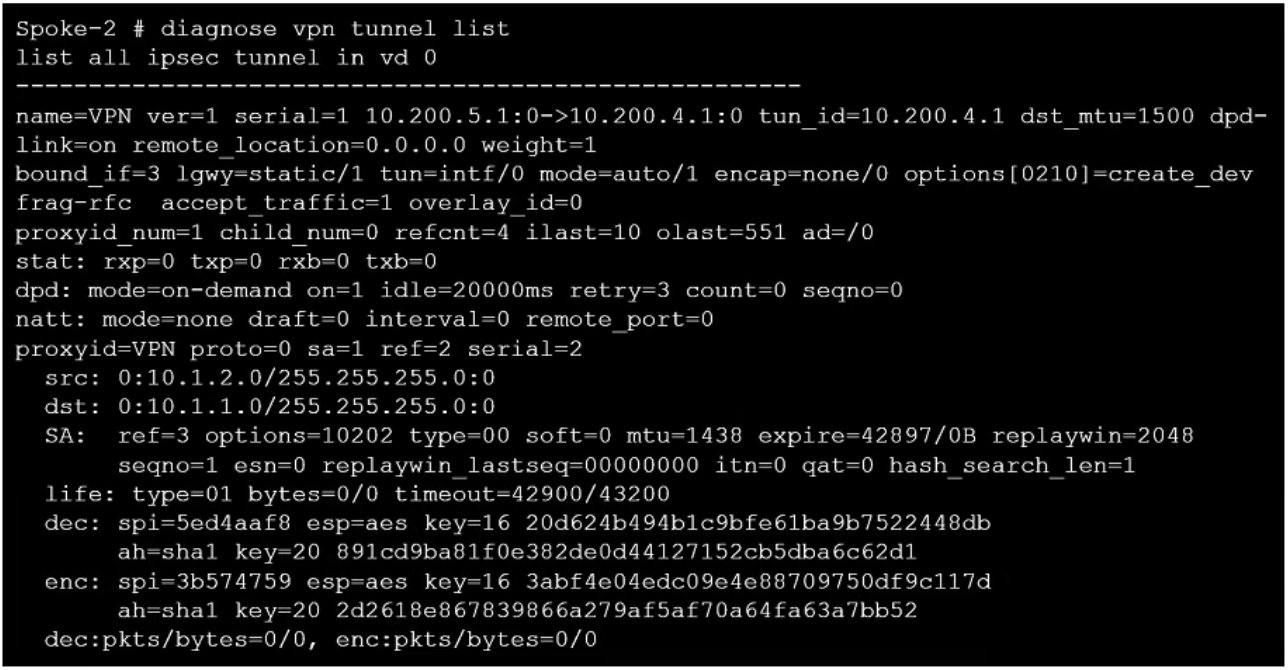Fortinet NSE7_EFW-7.0 Exam Practice Questions (P. 4)
- Full Access (60 questions)
- Six months of Premium Access
- Access to one million comments
- Seamless ChatGPT Integration
- Ability to download PDF files
- Anki Flashcard files for revision
- No Captcha & No AdSense
- Advanced Exam Configuration
Question #16
Refer to the exhibit, which contains the partial output of a diagnose command.

Based on the output, which two statements are correct? (Choose two.)

Based on the output, which two statements are correct? (Choose two.)
- AThe remote gateway has quick mode selectors containing a destination subnet of 10.1.2.0/24.Most Voted
- BThe remote gateway IP is 10.200.5.1.
- CDPD is disabled.
- DAnti-replay is enabled.Most Voted
Correct Answer:
AB
AB
send
light_mode
delete
Question #17
Which statement about the designated router (DR) and backup designated router (BDR) in an OSPF multi-access network is true?
- AOnly the DR receives link state information from non-DR routers.
- BNon-DR and non-BDR routers form full adjacencies to DR only.
- CNon-DR and non-BDR routers send link state updates and acknowledgements to 224.0.0.6.Most Voted
- DFortiGate first checks the OSPF ID to elect a DR.
Correct Answer:
D
D
 GPT-4o - Answer
GPT-4o - Answer
Correctly understanding the election process of the Designated Router (DR) in OSPF is crucial. The router with the highest priority is always elected as the DR. If there's a tie in the highest priority, OSPF ID then decides the winner. It’s important to note that the initial statement about FortiGate's election process relying solely on OSPF ID, as per answer D, is misleading. Priority is considered before the OSPF ID. This clarification aligns with real-world OSPF operations where router priority plays a fundamental role in DR elections, ensuring efficient network management and information dissemination among routers.
send
light_mode
delete
Question #18
An administrator has been assigned the task of creating a set of firewall policies which must be evaluated before any custom policies defined within the policy packages of managed FortiGate devices, across all 25 ADOMSs in FortiManager.
How should the administrator accomplish this task?
How should the administrator accomplish this task?
- ACreate a footer policy in the Global ADOM containing the firewall policies that must be evaluated first, and then assign this footer policy to all other ADOMs.
- BCreate a header policy in the Global ADOM containing the firewall policies that must be evaluated first, and then assign this header policy to all other ADOMs.Most Voted
- CMove the FortiGate devices into a single globally scoped ADOM, and merge policy packages, inserting the new firewall policies at the top.
- DUse a CLI script from the root ADOM on FortiManager to push these new policies to all FortiGate devices, through the FGFM tunnel.
Correct Answer:
B
B
 GPT-4o - Answer
GPT-4o - Answer
Absolutely, when you need firewall policies to be the first to hit across various management domains in the FortiManager, setting up a header policy in the Global ADOM is spot on. By doing this, these policies become the first line of evaluation before any individualized policies set within managed FortiGate policy packages, ensuring consistent preliminary policy application across all ADOMs. It's a streamlined approach to maintain order and precedence in large-scale environments.
send
light_mode
delete
Question #19
Which configuration can be used to reduce the number of BGP sessions in an IBGP network?
- Aroute-reflector enable
- Broute-reflector-server enable
- Croute-reflector-client enableMost Voted
- Droute-reflector-peer enable
Correct Answer:
A
A
 GPT-4o - Answer
GPT-4o - Answer
In configuring IBGP to minimize session count, activating the route-reflector-client is instrumental. This setup simplifies network design by allowing selected routers to act as reflectors, efficiently handling route information dissemination to designated clients within the network, circumventing the need for full mesh connections between all IBGP peers. This method not only streamlines the management of routing information but also optimizes resource usage across the network infrastructure. This understanding aligns with the configuration directives detailed in the Fortinet documentation, where 'route-reflector-client enable' is highlighted as the key operative command.
send
light_mode
delete
Question #20
Refer to the exhibit, which shows the output of a debug command.

What can be concluded from the debug command output?

What can be concluded from the debug command output?
- AThe OSPF router with the ID 0.0.0.69 has its OSPF priority set to 0.
- BThe local FortiGate has a different MTU value from the OSPF router with ID 0.0.0.2, based on the state information.
- CThere are more than two OSPF routers on the wan2 network.Most Voted
- DThe interface ToRemote is a broadcast OSPF network.
Correct Answer:
B
B
send
light_mode
delete
All Pages
